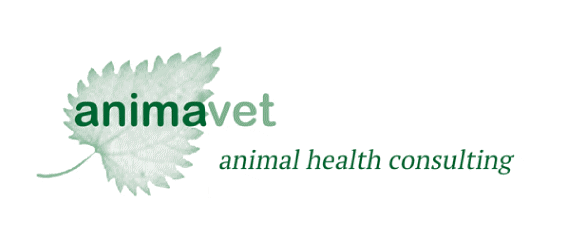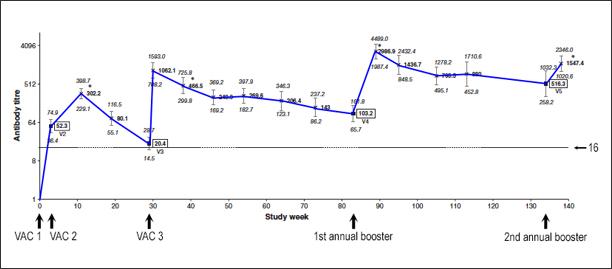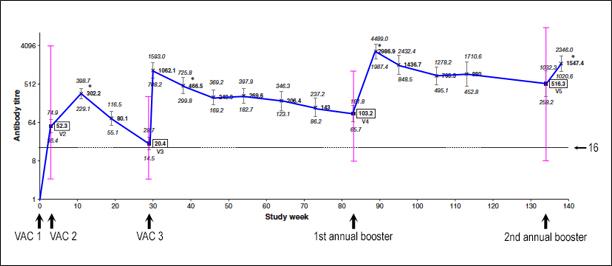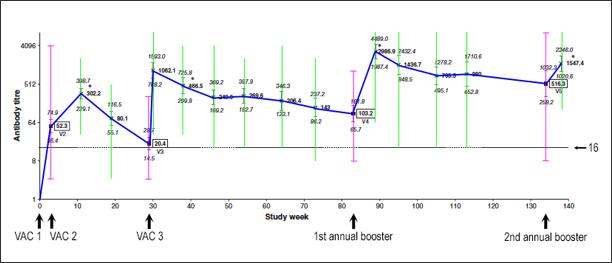
Christine King BVSc, MANZCVS (equine), MVetClinStud
Hendra: why not just go ahead and vaccinate?
Benefits
Field study
A field study of HeV vaccine safety and effectiveness was published in 2018. The stated goal was "[t]o determine the antibody responses to a commercial Hendra virus vaccine (Equivac® HeV) in a field environment."
The study used the research/teaching herd belonging to the James Cook University College of Public Health, Medicine, and Veterinary Sciences in Townsville, Qld. Because horses are always entering and leaving this institutional herd for various reasons, not all of the horses completed the full vaccination program or were available for the entire 2-year study period.
- Of the 61 horses in the herd when the study began, 57 horses received the first two vaccines; 38 horses also received the third; but only 29 horses were still in the study by the time the first annual booster rolled around, and only 26 horses were available at the second annual booster.
- The horses ranged in age from 2 years to 28 years, with an average age of 13–14 years. Most (49 horses) were Thoroughbreds; the rest were Standardbreds, Quarter Horses, or stock horses; there were no ponies, Miniature Horses, or draft breeds in the study group. Most (52 horses) were mares; the rest were geldings (8 horses) and one stallion.
Vaccination in this study followed the currently recommended protocol: 2 injections given 3–6 weeks apart, followed by a third dose 6 months after the second. This series of 3 injections is now considered the primary vaccination or immunisation course, after which annual boosters are recommended.
Blood samples for measurement of HeV antibody titres were collected immediately before and for variable periods after each dose of the vaccine was given. The horses were also monitored for any signs of adverse effects throughout the study.
Let's get that particular item out of the way first. In all, 206 doses of the HeV vaccine were administered during the study. According to the authors, "No local or systemic reactions attributable to vaccination were observed during this study and no adverse events following immunisation were recorded." That is consistent with the official reports of adverse events, which are said to occur with less than 1 in 400 doses of the HeV vaccine.
But note that the word attributable is doing some rather heavy lifting in that quoted sentence. (In case you skipped it, adverse effects of the HeV vaccine and under-reporting of adverse effects are discussed under Risks: the vaccine.) So, I don't think we can make very much of this finding.
Now to the meat of this study: HeV antibody titres.
In most of the horses in this study, the recommended vaccination protocol induced HeV antibody titres that can be expected to be protective in the face of viral challenge.
- As a reminder, the experimental vaccine challenge study showed that titres as low as 16–32 protected the horses from illness and prevented significant viral shedding in body fluids after HeV exposure through the natural route of infection (nose and mouth).
Below is a graph with the average titres at each time point linked in blue. (For the scientists, the individual points are geometric means and the little vertical bars represent their 95% confidence intervals, on a log2 scale Y axis.) The horizontal line running through the graph indicates a titre of 16.

Even the first vaccine of the primary series (VAC 1) induced a measurable antibody response in most horses. By the time the second vaccine (VAC 2) was due (3–6 weeks after the first), the average titre was already 52. We then see a bump up to an average titre of 302 after the second vaccine.
After the first vaccine, the average titre remained well above 16 at all time points except right before the 6-month booster (VAC 3), when the average titre had dropped to 20. So, this study shows that the booster given 6 months after the second vaccine is pretty important in most horses.
But then things get really interesting.
The study ended 4 weeks after the second annual booster. Notice that the average titres remained high after the 6-month booster (VAC 3), and they increased even further after the first annual booster, but there wasn't much of a bump after the second annual booster. That second annual booster appears not to have been needed in most horses. One could even question the need for the first annual booster in the average horse, based on this study.
Are we wasting money and increasing the risk of adverse effects by giving annual boosters to every horse?
It would be very good if HeV antibody testing became commonplace and the standard of care for horses in coastal Queensland and New South Wales.
Here's why:
Below is the same graph with the range of titres (minimum to maximum) among individual horses, in pink, overlaid on the averages. This graph shows the range of titres immediately before each vaccine was given...

... and the graph below also shows, in green, the range of titres among individual horses for all of the test days after each vaccine was given.

Lastly, here is the same graph with the upper and lower limits of the assay shown as horizontal orange lines.

- The upper limit was 8,192 and the lower limit was 8. Any values above this range were recorded as 8,192. How high they actually were, we don't know. Any values below this range were recorded as 'undetectable', even though the horse may have had some HeV antibodies in its blood and adequate cell-mediated immunity to protect against natural exposure to HeV.
The reason these limits are important is because the higher the titre, the longer it takes to fall below what we currently understand is a protective level. Immunologically speaking, boosters can be delayed in horses with high titres.
By the same token, a titre of less than 16 doesn't necessarily mean inadequate protection.
- In the 2018 study of diagnostic methods I've mentioned a couple of times, one naturally infected horse went from having a titre of less than 2 to a titre of 64 in about a week. The interval between viral exposure and first signs of infection, or the incubation period for this infection, is reported to be 5–7 days under experimental conditions and 5–16 days with natural exposure.
- Clearly, it is possible for a horse with a low or undetectable titre to significantly ramp up antibody production within that timeframe. It bears repeating that serum antibody titres are only one measure of a horse's immune response to vaccination or natural infection.
The authors don't tell us whether the same horses consistently had low titres, but based on research in other animals, that is most likely the case.
- So, how many horses in this study had 'undetectable' HeV antibodies (titres of less than 8)?
- At the start of the study, before the first vaccine (VAC 1) had been given, none of horses had detectable antibodies. This finding indicates little or no recent exposure to HeV in this group of horses when the study began, because we know that natural exposure does elicit an antibody response in horses.
- After the first vaccine, immediately before the second (VAC 2) was given, only 3 of 57 horses (5%) had undetectable antibodies. Put another way, antibodies were detected in 95% of horses after the first vaccine.
- After the second vaccine, immediately before the third (VAC 3) was given, 3 of 38 horses (8%) had undetectable antibodies. Were these the same 3 horses who had undetectable antibodies after the first vaccine? The authors didn't say. Regardless, antibodies were detected in 92% of horses after the second vaccine.
- After the 6-month booster, all horses had detectable antibodies (titre of 8 or higher) on every test day.
- By the time the first annual booster was due, titres had decreased in 21 of the 29 horses (72%) still in the study, but they remained 32 or higher in 26 of the 29 horses (90%).
All 29 horses still in the study when their first annual booster was due had a significant rise in titre after this booster, "consistent with reactivation of a secondary immune response." But with an average pre-booster titre of 103 (it ranged from 8 to 1,024) and 90% of horses in this group having pre-booster titres of at least 32, was this booster really necessary in most horses? Can it be delayed in many, or even in most, horses?
If HeV titre testing was more affordable, we would be able to answer both questions definitively for each individual horse. Until then, the data from this study indicate that the answers to these questions are no, annual boosters do not appear to be necessary, and yes, apparently they can be delayed in many, and perhaps even in most, horses.
- Based on the rate of decline in average titre following the 6-month booster (VAC 3), the average horse (blue line) in this study would not have needed another booster until 18 months to 2 years after the 6-month booster.
Things get even more interesting with the second annual booster...
At the second annual booster, titres had decreased in only 12 of the 26 horses (46%) still in the study. In other words, titres had remained largely unchanged in 54% of horses.
- It's worth noting, though, that in this study an 'increase' or 'decrease' in titre required a change of more than two steps:
- "When evaluating the rise and fall of antibody titres within individual horses, an increase or decrease in titre was considered to have occurred when there was a difference of more than two doubling dilutions between the two test results."
Put more simply, 25 of the 26 horses (96%) still had titres of 32 or higher when the second annual booster was due.
Most interestingly, only 5 of those 26 horses (19%) had a rise in titre after their second annual booster. Post-booster titres were unchanged in the other 21 horses (81%).
- "Statistically, there was no significant rise in mean antibody titre in response to V5 [second annual booster] compared with after V4 [first annual booster]. In fact, a slightly lower mean titre was recorded (P = 0.0007)."
What if, instead of annual boosters, we started doing annual HeV antibody testing. In my view, it would be better medicine to test all at-risk horses and booster only those who need it (e.g., those with negative HeV ELISA results) rather than giving annual boosters to every horse, whether they need it or not. There may even be better uptake of the vaccine by horse owners if we took this approach.
The results of regular HeV antibody testing would also resolve the problem of vets not wanting to treat horses and equine hospitals and equestrian events not allowing entry of horses who are not "current" on their HeV vaccination.
Read on...
Risks
Benefits
- the vaccine
- vaccination status
© Christine M. King, 2020. All rights reserved. Last updated 20 August 2020.